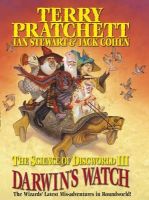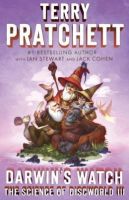 Title: The Science of Discworld III – Darwin’s Watch
Title: The Science of Discworld III – Darwin’s Watch
Author(s): Terry Pratchett, Ian Stewart, Jack Cohen
Release year: 2005
Publisher: Ebury Press
Why in Database: Third volume of a four-book series. Again, these books can definitely be called popular science, with the addition of Discworld. The chapters are arranged in turns, one about the magicians of the unseen university (generally shorter) and one about science in a broad sense, the third volume is about Darwin and the theory of evolution. As this book balances between the real world and the disc, there are many (in both perspectives) references to turtles (one is even on the cover). However, there are fewer of them than in the first volume, below we have selected a few more interesting:
The first selected quote is about how amazing the earth seems, from a certain perspective:
DISCWORLD IS REAL. It’s the way worlds should work. Admittedly, it is flat and goes through space on the backs of four elephants which stand on the shell of a giant turtle, but consider the alternatives. Consider, for example, a globular world, a mere crust upon an inferno of molten rock and iron. An accidental world, made of the wreckage of old stars, the home of life which, nevertheless, in a most unhomely fashion, is regularly scythed from its surface by ice, gas, inundation or falling rocks travelling at 20,000 miles an hour.
In the second quote, Ponder Stibbons describes the difference between traveling to the moon on disk and on earth:
`Things are different on a globe, sir. There are no broomsticks, no magic carpets, and going to the Moon is not just a case of pushing off over the edge and trying to avoid the Turtle on the way down.’
In the next fragment, we have reference (and quoted fragment) to the events described in Pyramids, another book by Pratchett:
However, he is up against a theoretical barrier, the paradoxes of the Ephebian philosopher Xeno, which are firstmentioned in Pyramids. A Roundworld philosopher with an oddly similar name, Zeno of Elea, born around 490 BC, stated four paradoxes about the relation between space, time and motion. He is Xeno’s Roundworld counteRepublic of South Africart, and his paradoxes bear a curious resemblance to the Ephebian philosopher’s. Xeno proved by logic alone that an arrow cannot hit a running man,[1] and that the tortoise is the fastest animal on the Disc.[2] He combined both in one experiment, by shooting an arrow at a tortoise that was racing against a hare. The arrow hit the hare by mistake, and the tortoise won, which proved that he was right. In Pyramids, Xeno describes the thinking behind this experiment.
”s quite simple,’ said Xeno. `Look, let’s say this olive stone is an arrow and this, and this -‘ he cast around aimlessly -‘and this stunned seagull is the tortoise, right? Now, when you fire the arrow it goes from here to the seag- the tortoise, am I right?’
`I suppose so, but-‘
`But, by this time, the seagu- the tortoise has moved on a bit, hasn’t he? Am I right?’
‘I suppose so,’ said Teppic, helplessly. Xeno gave him a look of triumph.
`So the arrow has to go a bit further, doesn’t it, to where the tortoise is now. Meanwhile the tortoise has flow- moved on, not much, I’ll grant you, but it doesn’t have to be much. Am I right? So the arrow has a bit further to go, but the point is that by the time it gets to where the tortoise is now the tortoise isn’t there. So if the tortoise keeps moving, the arrow will never hit it.
It’ll keep getting closer and closer, but it’ll never hit it. QED.’
The next quote again mentions paradoxes:
The second, Achilles and the Tortoise, is prettymuch the paradox enunciated by Xeno, but with the hare replaced by the Greek hero Achilles. Achilles runs faster than the tortoise – face it, anyone can run faster than a tortoise – but he starts a bit behind, and can never catch up because whenever he reaches the place where the tortoise was, it’s moved on a bit. Like the ambiguous puzuma, by the time you get to it, it’s not there.
Rincewind learns about the Galapagos tortoises:
`There’s going to be monster creatures on these islands we’re heading for, yes?’
`How did you know that?’ said Ponder.
`It just came to me,’ said Rincewind gloomily. `So there are monsters?’ `Oh, yes. Giants of their kind.’
`With big teeth?’
`No, not really. They’re tortoises.’
`How big?’
`About the size of an easy chair, I think.’
Rincewind looked suspicious.
`How fast?’
`I don’t know. Not very fast.’
Another fragment about Galapagos:
There were the spectacular giant tortoises that had given the islands their name. Darwin measured the circumference of one as seven feet (2m). There were iguanas, and birds – boobies, warblers, finches.
The last selected quote is about a turtle with wheels (shown on the cover), a creature developed by evolution god, a deity living in the discworld:
`That’s a giant tortoise!’ said Darwin, as it trundled past. `That at least is something – oh!’
`Yes.’
`It’s on wheels!’
`Oh, yes. He’s very keen on wheels. He thinks wheels should work.’
The tortoise turned quite professionally and rolled to a halt by a cactus, which it proceeded to eat,
daintily, until there was a hiss and it sagged sideways.
‘Oh,’ said a voice from the air. `Bad luck. Tyre bladder punctured. It’s the everlasting problem of the
strength of the integument versus the usage rate of the mucus.’

Author: XYuriTT
